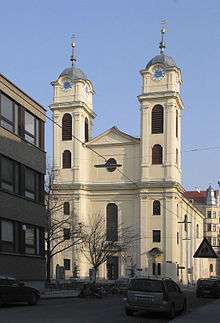Mass No. 3 (Schubert)
The Mass No. 3 in B-flat major, D 324, is a mass composed by Franz Schubert in 1815. It is four soloists, a four-part choiur and orchestra. While by length it could be a missa brevis, its large orchestral force with trumpets, timpani and woodwinds has also led to its classification as a missa solemnis.[1][2]
| Mass No. 3 | |
|---|---|
| by Franz Schubert | |
 Lichtental Church | |
| Key | B-flat major |
| Catalogue | D 324 |
| Year | 1815 |
| Form | Missa brevis et solemnis |
| Movements | 6 |
| Vocal | SATB choir and soloists |
| Instrumental | orchestra and organ |

Background
Schubert composed this mass setting a few months after his mass in G major, beginning on 11 November 1815.[2][3] The occasion for which it was composed is unknown; however, it is thought that the soprano soloist in the first performance was Therese Grob.[4] This suggests that it was written for the Lichtental Parish Church; Schubert may also have been attempting to create opportunities to spend time with Grob, with whom he was deeply in love.[3]
Its large orchestral component and extended orchestral interludes have been called "Haydnesque";[2] the latter's Nelson Mass has been cited as a particularly strong influence.[5] References to Mozart and Bach have also been noted.
While little is now known about the circumstances of the original performance, the mass was familiar outside Vienna. Schubert received a letter from his brother Ferdinand on 6 October 1824, saying that he had been asked to play the organ for a performance of a mass in Hainburg. The mass was by a famous composer whose identity was unknown to the invitees; upon receiving it, Ferdinand recognised his brother's work.[2][4]
Structure and scoring
The mass consists of six movements. Performances require approximately 30 minutes. It is scored for soprano, alto, tenor and bass soloists, a four-part choir (SATB), and an orchestra of 2 trumpets, . It is scored for soprano, alto, tenor and bass soloists, a four-part choir (SATB) and an orchestra of 2 trumpets, timpani, 2 oboes, 2 bassoons, violin I and II, viola and basso continuo (cello, double bass and organ).
In the following table of the movements, the markings, keys and time signatures are taken from the choral score, using the symbol for alla breve (2/2). The voices are abbreviated for the four-part choir (SATB), and the solo voices soprano (S), alto (A), tenor (T) and bass (B).
| No. | Part | Incipit | Voices | Marking | Key | Time |
|---|---|---|---|---|---|---|
| 1 | Kyrie | SATB S A T | Adagio con moto | B-flat major | 3/4 | |
| 2 | Gloria | SATB | Allegro vivace | B-flat major | ||
| Gratias agimus tibi | S T | |||||
| Domine Deus, Rex coelestis | SATB | |||||
| Domine Deus, Agnus Dei | B T S SATB | Adagio | D minor | 3/4 | ||
| Quoniam tu solus sanctus | SATB | Allegro vivace | B-flat major | |||
| 3 | Credo | Credo in unum Deum | SATB | Allegro vivace | B-flat major | 3/4 |
| Et incarnatus est | B S A T | Adagio | F minor | |||
| Crucifixus | SATB | |||||
| Et resurrexit | SATB | Allegro vivace | B-flat major | 3/4 | ||
| 4 | Sanctus | SATB | Adagio maestose | B-flat major | ||
| 5 | Benedictus | S A T B | Andante con moto | F major | ||
| Osanna | SATB | B-flat major | ||||
| 6 | Agnus Dei | S A T SATB | Andante molto | G minor | ||
| Dona nobis pacem | S A T B SATB | Allegro moderato | B-flat major | 6/8 | ||
References
- Shrock, Dennis (2009). Choral Repertoire. p. 383. ISBN 9780199716623.
- Black, Leo (2003). Franz Schubert: Music and Belief. p. 38. ISBN 9781843831358.
- Newbould, Brian (1999). Schubert: The Music and the Man. p. 36. ISBN 9780520219571.
- Howie, Crawford (2008). "Small is beautiful: Schubert's smaller sacred works". In Reul, Barbara M.; Bodley, Lorraine Byrne (eds.). The Unknown Schubert. p. 66. ISBN 9780754661924.
- Gibbs, Christopher H. (1997). The Cambridge Companion to Schubert. Cambridge Companions to Music. p. 209. ISBN 9780521484244.
External links
- Mass No.3, D.324 (Schubert, Franz): Scores at the International Music Score Library Project (IMSLP)
- Free scores of Mass No. 3 (Schubert) in the Choral Public Domain Library (ChoralWiki)